
The beardfishes consist of a single extant genus, Polymixia, of deep-sea marine ray-finned fish named for their pair of long hyoid barbels. They are classified in their own order Polymixiiformes. But as Nelson says, "few groups have been shifted back and forth as frequently as this one, and they were recently added to Paracanthoptergii". For instance, they have previously been classified as belonging to the Beryciformes. They are of little economic importance.
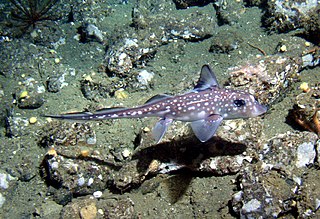
Chimaeras are cartilaginous fish in the order Chimaeriformes, known informally as ghost sharks, rat fish, spookfish, or rabbit fish; the last three names are not to be confused with rattails, Opisthoproctidae, or Siganidae, respectively.

The Molidae comprise the family of the molas or ocean sunfishes, unusual fish whose bodies come to an end just behind the dorsal and anal fins, giving them a "half-fish" appearance. They are also the largest of the ray-finned bony fish, with the southern sunfish, Mola alexandrini, recorded at 4.6 m (15 ft) in length and 2,744 kg (6,049 lb) in weight.

Quaesitosaurus is a genus of nemegtosaurid sauropod containing only the type species, Q. orientalis, described in 1983. It lived from 72 to 71 million years ago during the Late Cretaceous epoch in the Barun Goyot Formation. With long, low and horse-like with frontally located peg-teeth, the skull of Quaesitosaurus is similar enough to the skull of Diplodocus and its kin to have prompted informed speculation that the missing body was built like those of diplodocids.
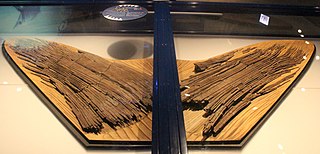
Leedsichthys is an extinct genus of pachycormid fish that lived in the oceans of the Middle to Late Jurassic. It is the largest ray-finned fish, and amongst the largest fish known to have ever existed.

Saurichthys is an extinct genus of predatory ray-finned fish from the Triassic period. It type genus family Saurichthyidae, and the largest and longest lasting genus in the family. This family also includes the Permian Eosaurichthys (China) and the Jurassic Saurorhynchus from Europe and North America, though it may be more appropriate to treat these as subgenera of Saurichthys, due to the genus Saurichthys otherwise being paraphyletic.
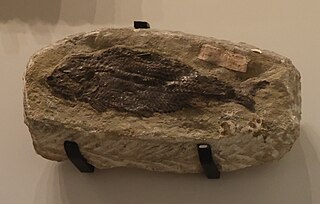
Pholidophorus is an extinct genus of stem-teleost fish. Numerous species were assigned to this genus in the past, but only the type species Pholidophorus latiusculus, from the Late Triassic of Europe, is considered to be a valid member of the genus today.
Gyrosteus is an extinct genus of very large ray-finned fish belonging to the family Chondrosteidae. It comprises the type species, Gyrosteus mirabilis, which lived during the early Toarcian in what is now northern Europe. A possible second species, "Gyrosteus" subdeltoideus, is known from otoliths.

The Palaeonisciformes (Palaeoniscida) are an extinct order of early ray-finned fishes (Actinopterygii). Palaeonisciformes sensu lato first appeared in the fossil record in the Late Silurian and last appeared in the Late Cretaceous. The name is derived from the Ancient Greek words παλαιός and ὀνίσκος, probably pertaining to the organization of the fishes' scales, similar to the exoskeletal plating of woodlice.
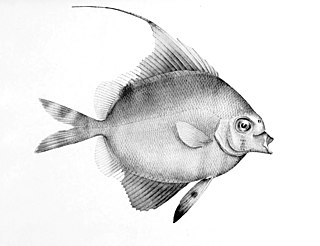
Sailfin moonfishes are a small family, Veliferidae, of lampriform fishes found in the Indian and western Pacific Oceans. Unlike other lampriforms, they live in shallow, coastal waters, of less than 100 m (330 ft) depth, rather than in the deep ocean. They are also much smaller than most of their relatives, up to 30 cm (12 in) in length, and have deep, rather than elongated, bodies. They are characterised by their ability to retract the anterior rays of their dorsal and anal fins into a sheath.

Scomber is a genus of fish in the family Scombridae living in the open ocean found in Atlantic, Indian and Pacific Ocean. The genus Scomber and the genus Rastrelliger comprise the tribe Scombrini, known as the "true mackerels". These fishes have an elongated body, highly streamlined, muscular and agile. The eyes are large, the head is elongated, with a big mouth provided with teeth. They have two dorsal triangular fins, with some stabilizing fins along the caudal peduncle. The basic color is blue-green with a silvery white belly and a darker back, usually black mottled.
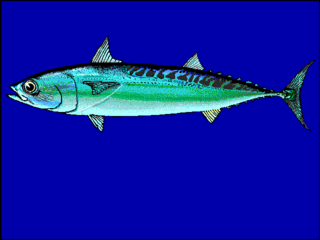
Auxis is a genus of ocean-dwelling ray-finned bony fish in the family Scombridae, and tribe Thunnini, also known as the tunas. Auxis, commonly and collectively called the frigate tunas, is one of five genera of tunas which comprise the Thunnini tribe.

Caranx is a genus of tropical to subtropical marine fishes in the jack family Carangidae, commonly known as jacks, trevallies and kingfishes. They are moderate- to large-sized, deep-bodied fishes which are distinguished from other carangid genera by specific gill raker, fin ray and dentition characteristics. The genus is represented in the Pacific, Indian and Atlantic Oceans, inhabiting both inshore and offshore regions, ranging from estuaries and bays to deep reefs and offshore islands. All species are powerful predators, taking a variety of fish, crustaceans and cephalopods, while they in turn are prey to larger pelagic fishes and sharks. A number of fish in the genus have a reputation as powerful gamefish and are highly sought by anglers. They often make up high amounts of the catch in various fisheries, but are generally considered poor to fair table fishes.

Boreosomus is an extinct genus of Triassic ray-finned fish. It was first described from the Arctic island of Spitsbergen, but was later also discovered in other parts of the world. Boreosomus belongs to the family Ptycholepidae. Other genera of this family are Acrorhabdus (Spitsbergen), Ardoreosomus, Chungkingichthys (China), Ptycholepis (global) and Yuchoulepis (China).

Saurichthyiformes is an extinct order of ray-finned fish which existed in Asia, Africa, Australia, Europe and North America, during the late Permian to early Middle Jurassic. Saurichthyiiformes comprise two families, Saurichthyidae and Yelangichthyidae. Whereas Yelangichthyidae is monotypic, Saurichthyidae includes at least two genera, Saurorhynchus and the very speciose Saurichthys. Additionally, the subgenera Costasaurichthys, Eosaurichthys, Lepidosaurichthys, and Sinosaurichthys are frequently used to group species. Saurichthyiforms were highly successful predators, and with Yelangichthys possibly even included durophagous forms. Species are known from both marine end freshwater deposits. They had their highest diversity during the Early and Middle Triassic.

Ptycholepiformes are an extinct order of prehistoric ray-finned fish that existed during the Triassic period and the Early Jurassic epoch. The order includes the genera Acrorhabdus, Ardoreosomus, Boreosomus, Chungkingichthys, Ptycholepis, and Yuchoulepis. Although several families have been proposed, some studies place all these genera in the same family, Ptycholepididae.

Tarasiiformes is an extinct order of prehistoric ray-finned fish.

Bobasatraniiformes is an extinct order of durophagous ray-finned fish that existed from the late Permian to the Middle Triassic in both marine and freshwater environments. The order includes two families: Bobasatraniidae, with the genera Bobasatrania, Ebenaqua, and Ecrinesomus, and Dorypteridae, comprising only the genus Dorypterus (monotypy). Bobasatraniiformes had a somewhat global distribution; fossils are found in Africa (Madagascar), Asia (Pakistan), Australia, Europe, and North America.

Ariomattidae is a family of marine ray-finned fishes which are classified within the suborder Stromateoidei of the order Scombriformes.

Pristigenys is a genus of marine ray-finned fish in the family Priacanthidae. It contains five extant species and one extinct species, P. substriata, which is known from fossils found in the Eocene of Monte Bolca, Italy.



















